#also i think it's no secret so shoma said he looks forward to talk with yuzu in some livestreams
Text
We get a reunion 🥳🥳🥳
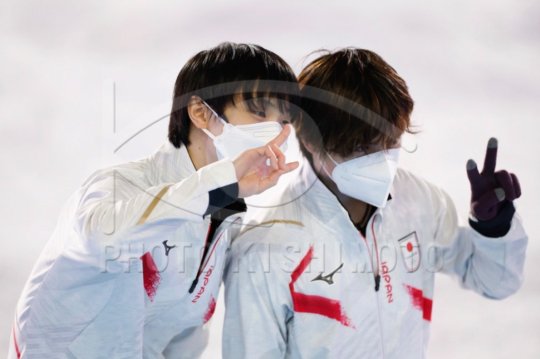
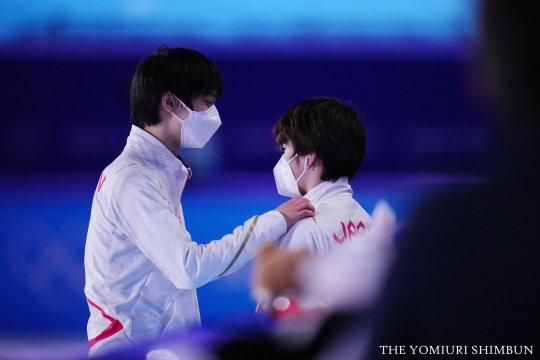



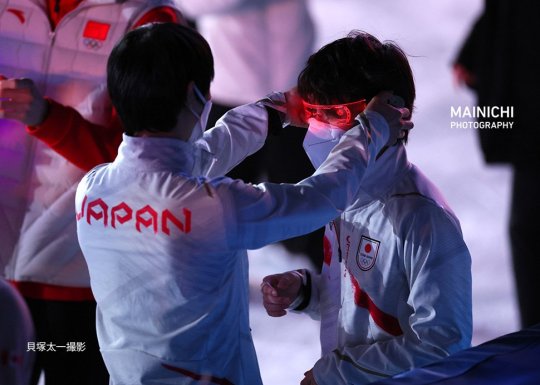
At Stars on Ice 2023 - a bit over a year later
#figure skating#yuzuru hanyu#shoma uno#yuzu and shoma#beijing 2022#I still wait for the first pic to drop from the one they posed for...like who do i have to pay to get the original 🤔#also i think it's no secret so shoma said he looks forward to talk with yuzu in some livestreams#even if he didn't say it unprompted but i still think if you chose to answer it also means a thing
47 notes
·
View notes
Text
Internationaux de France - Preview
Actually it’s more my pre-competition rambling instead of a genuine preview.
Men
So the men’s competition here will feature the anxiously awaited Nathan vs Shoma showdown (which shouldn’t even be happening because Shoma should have medalled at Worlds, but that’s another story). I think it’s no secret that I’m rooting for Shoma, but at the same time I think it’s unlikely that he has a chance of winning this. Nathan is getting overscored to the moon and back, and Shoma himself said that he’s not in top shape yet. I still wish him good luck and hope he can at least put out two performances he’s happy with and win silver.
Another skater I really like here is Kevin Aymoz. I hope he can skate as well as he did at ACI and hopefully have a shot at the bronze medal. Also want to wish good luck to Sergei Voronov.
Ladies
Since Kaori and Wakaba both have no chance at reaching the final anymore, I just hope they can have a great competition that will be a positive experience for them. I hope they have skates they’re happy with and maybe benefit from competing without as much pressure this time. (Theoretically Kaori still has a chance to reach the final, but she’d have to win here, which means defeating both Alina and Alyona, which is pretty much impossible unless they both make major mistakes.)
Speaking of Alina and Alyona, theirs is another anticipated battle for gold. I genuinely feel that everyone (maybe including RusFed?) who thinks that Alina has the easy route to the final is underestimating Alyona Kostornaia big time (and also underestimating Rika if we’re talking about NHK Trophy). In my opinion, if both of them skate clean there should be no question about Alyona winning this. Heck, even if she didn’t have a 3A, there should be no question about her winning this. Alyona has better components and better quality on almost everything. But as we know, Alina and inflated scores go hand in hand these days, so she actually has a shot here.
I also hope the insane pressure won’t get to Alyona. Both of her training mates have won their GPs, but she’s the only one up against the reigning Olympic and World champion. That can’t be easy to handle. I really hope Alyona can have a great competition (but leave Rika’s SP WR alone please?... it’s the only one she still has and I want her to keep it a little longer...)
I also want to wish good luck to Yuna Shiraiwa and Mae-Berenice Meite!
Pairs
There’s not that much to look forward to here (this is where James/Cipres were supposed to go, isn’t it?), but I still want to wish good luck to Hase/Seegert!
I’m desperately trying to stay positive and not think of any of the insane scoring we’ll see this weekend... I swear if they score Nathan anywhere close to Yuzu last week... or if Alina somehow scores higher than Rika last week... or if they announce another stupid award show...
#Figure skating#IDF 2019#Shoma Uno#Kaori Sakamoto#Wakaba Higuchi#Alena Kostornaia#Alina Zagitova#Nathan Chen#Kevin Aymoz#Sergei Voronov#Yuna Shiraiwa#Mae-Berenice Meite#Minerva Fabienne Hase#Nolan Seegert
6 notes
·
View notes
Text
“Figure Skating Fan” Magazine 2018-2019「羽 から生まれる」Translation

This is the interview with costume designer Satomi Ito on the construction of Yuzuru Hanyu’s Origin (and a little on Otoñal) costume featured on pages 42-43 of the February issue of フィギュアスケートファン (Figure Skating Fan) magazine released Dec. 22, 2018.
I’m formatting this to resemble the original formatting in the magazine.
Words after a long dash ------ are the interviewer talking/asking questions.
Words in「Japanese quotation marks」are Satomi’s responses.
Where text color changes for emphasis, I’ve used bold italics.
The interviewer tends to put technical terms, concepts, and key words in “quotations”. Which means:
When they bring up titles of literature, program names, and quoted phrases, those are in 『blocky quotes』instead.
Anything within (parenthesis) was originally in parenthesis within the article.
[words between brackets are my translator’s notes]
Following English conventions, I’m writing her name as Satomi Ito. For reference in Japanese: 伊藤聡美 いとうさとみ Itou Satomi
The interviewer/writer is いとうやまね (Itouyamane) - a writer unit composed of Itou Miho and Yamane Seiji.
I’ve left the honorifics. They refer to Yuzuru as “Hanyu-senshu” (athlete Hanyu) throughout the entire article. -senshu is the respectful term for athletes.
-san is the general honorific (Mr./Ms./Mrs.).
----------------------------------------
I agonized over capturing the ways they said certain phrases, but even so, I’m just an amateur translator, which means there are some turns of phrase I probably could have translated better. I originally wrote this all by hand, so there’s no Japanese transcription typed up, but if you’d like a specific section to see what exactly they said, send me an ask or a message and I’ll be happy to type that up.
For more learning, sewing/fabric/technical terms will have a glossary at the bottom, along with various notes.
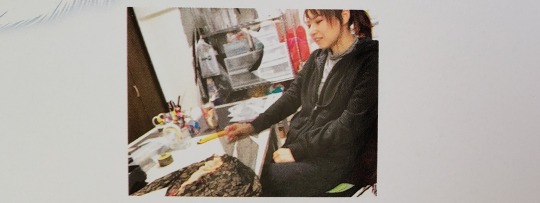
INTERVIEW[<---the original text is actually in English, but misspelled as INTERVEW]
Costume Designer・Satomi Ito
「羽 から生まれる」Born from feathers
Here is Origin’s “temporary-stitched”[baste-stitched] costume. Black lace on a flesh-toned base, and velour pants. In costume designer Satomi Ito-san’s atelier, she let’s us see the “idea’s prototype.”
Interview/text: Itou Yamane
100 feathers
-----Black and white feathers are being attached to the lace on the upper body, aren’t they! Although it’s surprising that the feathers are all handmade.
「I made all of them here. First, I cut leaf shapes with a rotary cutter, then I cut into the sides with scissors. The black is [made of] PowerNet, the white is a 2-way with a bit of thickness. Both are fabrics with elasticity. One by one, I would sew this by hand.」
-----It must be a large number of feathers isn’t it?
「I wasn’t counting, but it’s probably around 100. I don’t know the exact number of feathers that I’ve cut each and every time. I’ll feel like “it’s not quite enough, huh” so they increase. The entire weight is light, though.」
-----When I first saw what Hanyu-senshu was to wear, a structure, or should I call it a construction?, I thought “it’s like an architectural structure.” By way of intricate three dimensionality, there’s a sense of great depth.
「I’m doing that quite consciously. If you just simply put the feathers down it won’t feel very 3D, so I kind of group creases to make it feel like the feathers float. When it’s just right, I pin it.」
-----As for the white feathers, there’s also a gradation on the front side, huh.
「The appearance would be too jarring if white abruptly appears on the black fabric, so I put in a bit of airbrushing. Filling just the center part with black. Furthermore, there’s factoring in the sketch too. Whatever pattern there is. I’d try and put it on the [mannequin] torso and it’s like let’s place this feather on this area.」
-----You do the airbrushing on the styrene boards by the wall, right?
「I’ll fasten with pins. Lining up a large quantity.」
-----On these boards, numerous......starting from Hanyu-senshu, [Shoma] Uno-senshu, [Marin] Honda-senshu, [Wakaba] Higuchi-senshu, [Mai] Mihara-senshu, and others. Thinking about the airbrushing for the various costumes, I’m deeply moved. I thought “is this fine art”?
「It’s not. (laughs)」
-----The inlet-like form of the chest is wonderful isn’t it. I was impacted by the inlet being composed of black feathers.
「To start, I cut the lace on the chest area roughly, then apply the feathers there. In the middle of that process, I also cut hole shapes here and there in the lace. It’s a sense of torn holes.」
-----Also on the lace itself there’s an intricate pattern of light-and-dark, furthermore, you make light skin-tone portions. This is the secret of “depth” isn’t it.
「And I put feathers on top of that. I’m pretty interested in this technique. Of all the costumes I’ve made for Hanyu-senshu so far, this one is my favorite.」
-----The curves on the back are also technical. The detailed flow of gold is beautiful. It’s a little terrifying.
「I kind of thought it’d be nice if it looks a bit bone-y. I could do lines which run along the shoulder blades. Then in addition the crawling-like gold stones and bugle beads, and putting in purple rhinestones too.」
-----At the sketch stage, did you have an image for the white feathers?
「At first I was thinking of just black feathers. But because that didn’t really stand out, I kind of thought maybe adding in white feathers would better bring out the “sense of feathers being attached.” I’m glad I did put them in.」
-----It’s effective. The amount and arrangement are also nice.
「As for the design image, the [costume’s] flow changed a little. The result: I was correct that the feeling of ascending/rising would come out more than before. Entering production, I mostly don’t look at the design image. I won’t know the full picture not putting it on the [mannequin] torso and making it. Although because there is the initial image, there are times where I do more-or-less stick to it. That’s why the completed piece isn’t faithful to the sketch.」

The concept is from the “surname”
-----As for these costumes, for stuff like attaching feathers, or setting rhinestones, to give some examples, was there an assistant?
「For 『Origin』, the craftsmanship is brutal, so I did it all myself. For the Short [Program] 『Otoñal』 I received help.」
-----This is about the part most essential to a designer. Can we say that the design’s concept comes from Hanyu-senshu’s “surname”?
「『The nonhuman born of feathers』. All along I’ve thought I want to make a costume with that theme. This time it came true.」
-----Hanyu-senshu feels superhuman doesn’t he. He’s not an ordinary human. Shae-Lynn Bourne also said as much.
「The Hanyu name, isn’t that by itself cool? The song’s starting pose too, it has the air of spreading one’s wings. Although I knew absolutely nothing of the choreography, so having the image link pretty well was surprising.」
-----I thought you must have heard the concept for the choreography beforehand. It seems Shae-Lynn conceived it from the 『Kojiki』. Without establishing some [sort of] story and image with the choreography, the world won’t unfold, I heard.
「Design is like that too, isn’t it. With nothing, you can’t create. That is the same. Hanyu-senshu is Hanyu-senshu, so he likely has yet other different ideas.」
Each Individual 『Origin』
-----From this one piece various worlds unfold, it’s wonderful isn’t it. I as well, from the concept 『born from feathers』and the 『Kojiki』information, researched various things on birds coming from Japan’s creation myths. I also more-or-less tried reading the English version『KOJIKI』. Because I was interested in how it’s conveyed to foreigners.
「Was there something?」
-----Quite a lot of birds appear. Within those, the black Yatagarasu and the golden kite, after that I came across the egret that Yamato Takeru, on the cusp of death, metamorphosed into and flew away. I thought “this is nice,” and I wrote it in the [article] column.
「There’s a story nature to it, right? Exactly. Although, I didn’t consider it to that extent when I designed [it] (laughs).」
-----Hanyu-senshu himself likely wasn’t thinking of the『Kojiki』either. I think it’s good that the performer, creator, narrator, and fans each have their own 『Origin』. As for the design check-in, did you send the image to the person himself [Yuzuru]?
「This time, because I was able to take the time to meet personally with Hanyu-senshu, the design image and fabric were shown at the place to him himself. As for baste-stitching, it’s done when he’s in Japan at ice shows and such.」
-----What about the final fitting?
「That’s also just before he flies to the actual competition. The product delivery itself is passed on through the manager.」
-----About how long did it take to design and construct the costumes this time around?
「The ornamentation alone takes 1-2 weeks. From design to product delivery it takes about 2 months. For 『Origin』 the image solidified relatively quickly, but the Short kinda ended up taking a lot more time.」
-----The blue of the Short is pretty too, isn’t it. Rather than fall, [it’s] winter-like. The crackling line of rhinestones is characteristic.
「It’s the image of ice crystallization. And you can also see it as the tracings left by blades on the rink. He’s the champion of the ice, so I thought it would be nice if [the costume] could have that symbolization. Because he’s the young noble of the ice.」
-----We can say the fundamental [costume]order was the blue and black-gold of the tributes’ original designs from Johnny Weir-san and Plushenko-san, but could you also be making alternate versions?
「The Short and Free each have two [costumes]. The B version too is a similar feel.」
-----I’m looking forward to the day we can see those too. First off, wishing for Hanyu-senshu’s return from his injury.
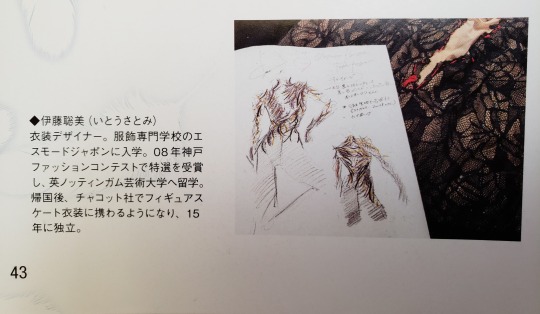
(Itou Satomi)
Costume designer. [After high school] enrolled in the Esmod Japon school of fashion and design. The ‘08 Kobe Fashion Contest special choice award winner, studied abroad at England’s Nottingham Trent University School of Art & Design. After her return, [while] at Chacott she came to be engaged in figure skating costumes; [has been] independent for 15 years.
--------------------------------------------------------------------------------
Glossary/Notes:
Baste-stitching - a temporary loose stitching to hold the pieces of fabric together while the initial form and alterations are being made.
PowerNet fabric/PowerNet mesh fabric - a type of high compression 4-way stretch fabric
2-way fabric - fabric that stretches in 2 directions, meaning it has some elasticity (4-way fabric stretches in all four directions)
bugle beads - the thin tube-like beads often associated with embroidery
the title of the article 羽から生まれる“Born from feathers” or “Born of feathers” is a pun on Yuzuru’s last name: 羽生
In a previous interview, Satomi talked to Itou Yamane about her past work focusing on fashion as architectural structures, and deciding which kind of architectural design to use as a motif. Which is why the interviewer brings up “structure, or should I say construction?, architectural structure”
I translated this 王者 as “champion,” because it’s slightly different from the court title “king”王様. Satomi is giving reasoning behind her expression of ice crystallization - saying that he’s a champion (“ouja”) of the ice, then adding further: “because he’s the young noble of the ice”- which would sound a bit odd and redundant if she had just called him a “king.”
Yamato Takeru and the egret - "isn’t it a swan?” The Japanese text is 白鳥 which normally would mean “swan”(hakuchou), but in parenthesis the interviewer clarifies the reading as “しらとり” (shiratori). It seems the white bird that’s referred to as 白鳥 in the Kojiki and Nihonshoki is considered to be referring to the bird 白鷺 (shirasagi) in modern Japanese. Here’s a site (JP only) about the myth, with pics of the shrine.
the interviewer tweeted pics too
The column that the interviewer mentions, I think they’re talking about how they wrote down the birds to mention in this interview column itself. They’ve written various pieces before for magazines and online articles, and they published a book last year called 氷上秘話―フィギュアスケート 楽曲・プログラムの知られざる世界 (secrets on the ice - knowing the world behind figure skating songs and programs). They dig up information on the music, art, design, history, and legends (basically, an entire meta book on theories and relevant links), and shed light on the actual choreography and program’s concept. So it’s possible they could be writing something else too.
I want to include photos of the full two pages, but I feel that’s probably something I shouldn’t do... so I’ll wait a while longer and then edit this post.
#satomi ito#interview#figure skating#yuzuru hanyu#origin#otonal#my translation#translation#フィギュアスケートファン#figure skating fan magazine#itouyamane#itou yamane#magazines
325 notes
·
View notes